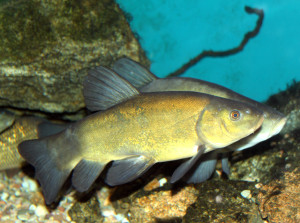 Its Russian common name is derived from the verb to shed, as this fish immediately changes color once out of water. Tench are widespread almost all over Europe (it is absent from the Norwegian, White and BarentsSeas), and in the midstream of the Ob and Yenisei in Siberia. It is a secondary commercial fish of the Pskov-PeipsiLake. Its thick and fairly wide body is covered in tight fine scales, with two small magenta eyes set in the head. The mouth is very small, with a short barb in each corner. Pharyngeal teeth are single-row, curved in a small hook. The coloration of the tench depends on the color of the water it inhabits; usually its back is dark green, flanks are olive green with golden sheen, but in rivers and lakes it is always yellower than in shadowy, overgrown ponds. Tench grow 60 cm long and 7.5 kg in weight. They prefer to stay in river reaches and lakes overgrown with bulrush or soft submerged plants like water milfoil. It is a solitary fish. Before wintering, they gather in schools and hibernate in deep spots, dug up in ooze sometimes. The tench feeds on small benthic invertebrates. It spawns first when 3-4 years of age. The outward rays of the pectoral fins in males are greatly incrassated, so the sexes are easy to tell. Tench are thermophilic, spawning in June-July with the water at 19-20°С, and laying eggs to plant stems. Spawning is intermittent, lasting 1.5-2 months. Tench are welcome in warm-water fish farms, as they are very undemanding to water quality and may live in ponds unfit for carps. An artificially-bred variety of tench called golden tench are quite common in German ponds. In natural water bodies, tench are of low commercial value, yet its farming is considerable.
Its Russian common name is derived from the verb to shed, as this fish immediately changes color once out of water. Tench are widespread almost all over Europe (it is absent from the Norwegian, White and BarentsSeas), and in the midstream of the Ob and Yenisei in Siberia. It is a secondary commercial fish of the Pskov-PeipsiLake. Its thick and fairly wide body is covered in tight fine scales, with two small magenta eyes set in the head. The mouth is very small, with a short barb in each corner. Pharyngeal teeth are single-row, curved in a small hook. The coloration of the tench depends on the color of the water it inhabits; usually its back is dark green, flanks are olive green with golden sheen, but in rivers and lakes it is always yellower than in shadowy, overgrown ponds. Tench grow 60 cm long and 7.5 kg in weight. They prefer to stay in river reaches and lakes overgrown with bulrush or soft submerged plants like water milfoil. It is a solitary fish. Before wintering, they gather in schools and hibernate in deep spots, dug up in ooze sometimes. The tench feeds on small benthic invertebrates. It spawns first when 3-4 years of age. The outward rays of the pectoral fins in males are greatly incrassated, so the sexes are easy to tell. Tench are thermophilic, spawning in June-July with the water at 19-20°С, and laying eggs to plant stems. Spawning is intermittent, lasting 1.5-2 months. Tench are welcome in warm-water fish farms, as they are very undemanding to water quality and may live in ponds unfit for carps. An artificially-bred variety of tench called golden tench are quite common in German ponds. In natural water bodies, tench are of low commercial value, yet its farming is considerable.
/ * The photos at lake.peipsi.org are cross-posted from commons.wikimedia.org and are used for familiarization purposes only. No commercial use of the photos is allowed. For more information about to use the photos see the originals on commons.wikimedia.org. /


